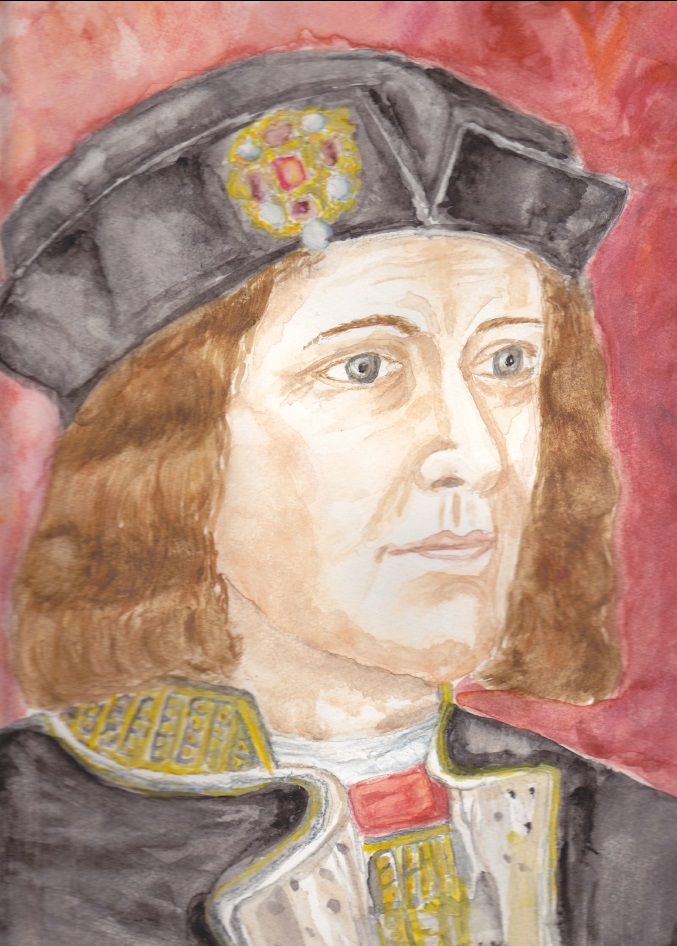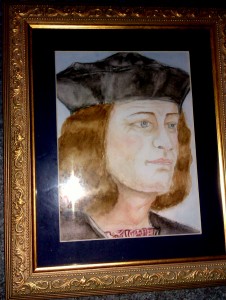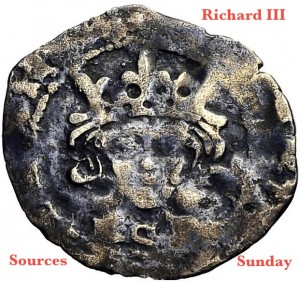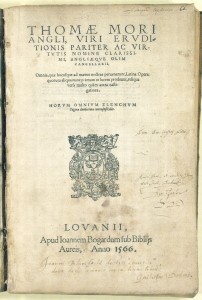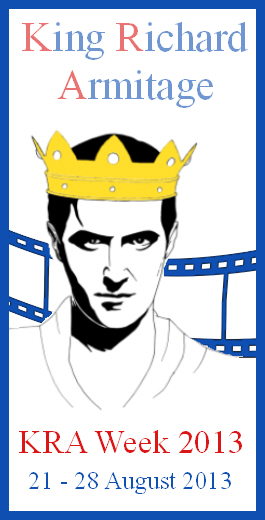A Church for the King
♛ King Richard III ♛
- ThisIsLeicestershire.co.uk: ‘Our best guess at Greyfriars’, by Dan Martin (18.05.2013) – PhD student Asem al Bunni (De Montfort University) built the assumed outlook of the Grey Friars Church in Leicester after assumptions and research done by Dr. Ashdown-Hill in his book “The Last Days of Richard III”.
- De Montfort University, Leicester: DMU re-creates Richard III’s long-lost friary (20.05.2013) – Speculations about the Greyfriars’ church and St. Mary-in-the-Newarke, where King Richard III may have been on public display before his burial in the Greyfriars church.
- University of York: Richard III: History’s man and Shakespeare’s villain. Speakers at the event on Sunday 23 June 2013: Chris Skidmore, Mark Ormrod and Judith Buchanan (21.05.2013) – Admission to the event in the Berrick Saul Building at the University of York is free, but booking is required!
- University of Leicester: Was Richard III a benevolent king or a murderous tyrant? (Press release: 21.05.2013) – Free event and open debate on 6 June 2013. [As reported already in last week’s news.]
- Middlehamonline.com: Richard the Third Weekend – 5th – 7th July 2013 – As I can’t link to the event itself, just to a general news page, I will quote the even description here:
RICHARD THE THIRD WEEKEND
Friday 5th July 2013:- – The weekend will start on Friday from the Chruch of St Mary’s & St Alkeldas with a children’s procession to the Castle where the children will be presented to King Richard & Queen Anne.
- – The raising of Richard’s personal pennant from Middleham Castle.
Saturday 6th July 2013:
- – Country Market – Market Place Middleham
A selection of stalls reflecting country gifts, skills and produce- – King Richard & Queen Anne will process through Middleham
- – Wandering Minstrels
- – Castle re-enactments and audiences with Richard & Queen Anne
- – Hog Roast
- – An evening Talk covering Richard’s life and death
by the Historian Steven Brindle, Philippa Langley of the Richard III Society and Professor Sarah Haisnworth of Leicester University- Refreshments included in ticketprice of £18 per person
Sunday 7th July 2013:
- – Middleham Castle
an audience with King Richard & Queen Anne- – Re-enactments archery etc.
- – Wandering Minstrels
- – Craft Fair at the Key Centre
- – Refreshments etc. acailable
- – Market Place afternoon into evening
- – Tilt The Bucket
- – Barbeque food etc.
♛ King Richard Everywhere ♛
- The Atlantic: The Uncanny Face Model They Made With Richard III’s Skull, by Megan Garber (17.05.2013) – Is King Richard III bringing a new dimension into history? Certainly the third…
- ThisIsLeicestershire.co.uk: Letter from Richard III’s mother discovered in America, by Leicester Mercury (21.05.2013) – Though the article contains the common error to declare Richard III, before becoming King, to have been Duke of York like his father, instead of his real title as Duke of Gloucester, it reamins to be seen how much the proposed letter by Richard’s mother, Cecily Neville, can shed new light on King Richard III.
- ThisIsGloucestershire.co.uk: Gloucester ‘snubbed’ on national tour of Richard III’s reconstructed face, by The Citizen (21.05.2013) – King Richard III everywhere? – Apparently not …
- ThisIsLeicestershire.co.uk: Deadline nears in Richard III row, by Dan Martin, Leicester Mercury (21.05.2013) – Are the relatives of King Richard III a ‘distraction’?
Royal News
♛ King Richard III ♛
- Crossville Chronicle: Small Town Girl: Britain’s missing royalty, by Caroline Selby (09.05.2013) – King Richard III potentially not the child murdering king on the throne of England? The tide seems to turne in the king’s favour. What King Richard III so hard fought for, to have the benefit of the doubt, finally seems to reach the media.
- University of Leicester: Richard III Open Day for all the family (13.05.2013) – More information about the schedule for the Richard III Open Day on Saturday 29th June 2013 at the UoL website here.
- University of Leicester: Live event – Richard III: Benevolent King or Murderous Tyrant? (13.05.2013) – Debate and question time about King Richard III at this live event on Thursday 6th June 2013, with
Phil Stone, Chairman, Richard III Society
Paul Lay, Editor, History Today
Dr. Mary Ann Lund, University of Leicester
Questions can be sent in to: lexchanges[at]le.ac.uk
Tickets for the event are free, though places are strictly limited. So reserve your spot fast. - DigitalJournal.com: Leicester Cathedral hosts past and present English monarchs, by Elizabeth Batt (10.05.2013) – A report about Leicester Cathedral and its history with beautiful images. That even present royalty sees it as a worthy place to visit, might be an argument to make the place more suitable for a ‘past king’.
- Simon Fraser University, Vancouver: SFU hosts talk by experts who discovered Richard III’s skeleton (13.05.2013) – Dr. Turi King and Jo Appleby held a talk about the research results about King Richard III in Vancouver. – Unfortunately got the alert to the event by the Simon Fraser University only at the day it was held. Still I hope, we will get further information about the event and its content later on.
- ThisIsGloucestershire.co.uk: Citizen Big Issue: Gloucester city councillor and Richard III Society member Seb Field (14.05.2013) – Seb Field’s statement for Gloucester and an open approach to history and King Richard III.
♛ King Richard Everywhere ♛
You want to play King Richard III? – If you are in the age between 14 and 19, you have a chance here:
- Brattleboro Reformer: NEYT Casting for ‘Richard III’ (15.05.2013) – King Richard III here unfortunately not a role for Mr. Armitage, but hopefully his part will work out soon. The New England Youth Theatre is giving teens the chance to play “one of Shakespeare’s most murderous plots”.
- Times Herald Record: Make your wishes known regarding funeral, burial, by Bonnie Kraham, Guest columnist (09.05.2013) – I wonder whom King Richard III should have given his exact instructions. His wife and son were dead already and none of his siblings or any of his intructions survived long enough to prevent him from being quareld about now.
- The Guardian: Diary: It’s the Wars of the Roses again. And this time it’s on Facebook. It started under a Leicester car park, and almost inevitably involves a boycott of Walkers’ crisps, by Stephen Bates (15.05.2013) – Took me a while to figure out that the later bullet points have nothing to do with the headline of the article.
- Helen Rae Rants (Blog): Literature Matters: The White Queen (16.05.2013) – Ms. Rae reviews the book basis of the soon on TV series “The White Queen” by Philippa Gregory. She shows some of the reasons, why this film and book are no topic on the KRA website, though King Richard III appears in them.
- On Line Opinion.com.au: Darth Vader – the good guy who lost, by Mark S. Lawson (17.05.2013) – What King Richard III and Darth Vader have in common. You wonder? – Hm…, so do I. But after reading the article, you will certainly try to defend Darth Vader, the misunderstood leader, who’s history was written by the winners.
If you want to show where your favours lie, please consider taking part in our poll about adequate procedures for King Richard III’s burial.
You missed Star Wars terribly here on the KRA website? Now here comes a treat for you:
King Richard Everywhere …
♛ King Richard Armitage ♛
Richard Armitage currently had a promotion tour for “The Hobbit” in Sydney, Australia.
In one of the interview sessions with an audience, hosted by Popcorn Taxi, where fan-questions were allowed, the question of his interest in King Richard III turned up. Mr. Armitage gave the following answer (Quoted after the transcript by Groovergreen on fedoralady’s blog TheArmitageEffect):
Does he still plan to play Richard III on film?
RA: “Many, many plans but they are all in my mind at the moment. There is a possibility but it is a matter of when and how. Maybe I’ll be too old to do it.’’ (Collective groan of disbelief from the Armitage Army in the front rows.)
(Strangely the question, like another already previously mentioned elsewhere, is completely missing in the pronounced full transcript of the Q&A session on TheOneRing.net, while no gap is indicated.
But already two fans independently reported to have heard this question and his answer at this event, so it is sufficiently confirmed to have been part of the evening in Sydney on May 1st, 2013.)
♛ King Richard III ♛
- Current Archaeology Live!: The King under the car park. The search for the last known resting place of King Richard III, by Carly Hilts (01.05.2013) – Presentation about the process of the discovery and find by Richard Buckley, Archaeological Services, University of Leicester the 2nd of March, 2013:
- Helen Rae Rants (Blog): History Matters: More Ricardian Rubbish, by Helen Rae (03.05.2013) – Response from a Ricardian to the late article in The Guardian about the deductions about King Richard III and his life from the state of his teeths.
- ThisIsLeicestershire.co.uk: Richard III Society responds to “slab not tomb” decision, by Alan Thompson (06.05.2013) – The Richard III Society now takes open position against a slab and for their design of a tomb, which was designed with much sensitivity and care for the dignity of the deceased king of the late 15th century.
- ITV.com: Former King’s distant relative to lead march through York (06.05.2013) – A march through York took place at noon on May 6th, 2013, lead by King Richard III’s 16th grade grand niece Vanessa Roe.
The march went from the Castle Museum at 12 noon and arrived at Museum Gardens at 2 pm. - BBC: Richard III burial row campaigners march through York (06.05.2013) – With video interview with Vanessa Roe, a 16th generation great niece of King Richard III.
- The York Press: Marchers mass in York as row over Richard III hots up, by Richard Catton (07.05.2013)
- ThisIsLeicestershire.co.uk: Richard III visitor centre boss sets out his vision, by Peter Warzynski (08.05.2013) – The team behind the planned visitor centre for King Richard III in Leicester.
♛ King Richard Everywhere ♛
- Savannahnow.com: Free enterprise: Crowd sourcing into the future (03.05.2013, updated 04.05.2013) – How King Richard III even can appear in unlikely topic combinations. Here interwoven with great skill.
When clouds appear, wise men put on their cloaks
- University of Birmingham: Richard III: The real king of history, or marvellous theatrical villain?, by Prof. Michael Dobson (about 01.05.2013) – Please follow the link “Read full opinion” to see the full statement.
- Los Angeles Broadway World: BWW Interviews: Denise Devin on Researching RICHARD III for Zombie Joe’s Underground, by Ellen Dostal (04.05.2013) – A new apporach to Shakespeare’s play about King Richard III – The effect the find in Leicester already has on the interpretation of the dramatic play by Shakespeare.
- TheNorthernEcho.co.uk: Beer brewed in honour of king launched at annual Yorkshire Dales food and drink festival, by Joe Willis (02.05.2013) – Is there even a report if King Richard III liked beer? The current reports about him eating too much suggar do not convince me right now, not after the bad state of teeth in the late Middle Ages in general. But I certainly like a toast brought out for King Richard III with a beer King Richard III and potentially acompanied by a cheese King Richard III. What a feast!
King Richard III Cheese – as it should be, pure white for the White Rose of York. - BBC: Richard III burial row campaigners march through York (06.05.2013)
Please do understand, that the article lists here on KRA will not take up every topic or mention of King Richard III, but strongly select, what really contains some new information and might be of interest to historically interested and film- and Richard Armitage supporting readers of this blog.
A Late Medieval King in Modern Times
A Medieval King certainly needs an impressive royal portrait. Unfortunately, King Richard III was a bit under represented in the art of his time, which might be due to the fact that his successor King Henry VII was not all too fond of his image.
Now with a bust re-constructed from King Richard III’s skull, we can rectify that.
LDixon157 based her portrait on the new research as well as on one of the earliest surviving portraits painted after his death and created an impressive royal portrait of King Richard III:
LDixon157
contributed her wonderful water colour painting of King Richard III.
See more of her work here: LDixon157 on Flickr
♛ King Richard III ♛
King Richard III is found, but still, lots of questions remain to be answered. Only one of those questions is, where King Richard III should be buried. Though a fast answer seems unlikely, now that this question goes to court and an answer to this delicate problem of ancestry, relation and prerogative of distant descendants needs to be found there.
- University of Leicester: Archaeology Team Bids to Extend Search at Historic Church Site (30.04.2013) – The archaeological Sevices of the University of Leicester have applied to the Ministry of Justice for a further exhumation licence (a stone coffin has been found, presumed to be of a medieval knight called Sir William Moton, buried at Grey Friars Chruch in 1362) and to the City Council, to extend the previous dig and find out more about the Church of the Grey Friars where King Richard III was buried.
City Mayor Peter Soulsby about the digging request:Our aim is for the gravesite located within 6-8 St Martins to become part of the new visitor centre, and the removal of part of the wall will be necessary to make this happen. This application is therefore a step forward in the development of the site.
The archaeological excavation is planned to start at the beginning of July 2013 and will last about 4 weeks. The public is intended to get opportunity to see the work in progress.
- The York Press: Richard III legal fight to start next week, by Kate Liptrot (27.04.2013)
- Green Valley News & Sun: Genealogy Today: Richard III reinterment in dispute, by Betty Malesky (28.04.13) – Discussions that King Richard III’s grave should show his good and bad sides, just do not get my full support. For one, who are we to decide which one’s of his sides were which and for another, when we know so little about him for sure, how can we decide at all? A further reason, why I don’t like this discussion, started by the Cathedral of Leicester, is that other kings, obviously and certifiedly having murdered people in bulks, did receive glorious funerals and graves. Why should we now diminish King Richard III’s status in comparison to other kings who were not an ounce better, but possibly worse? Is proven infamy for kings the way to a glorious funeral and suspicion diminishes the likelyhood?
- ThisIsLeicestershire.co.uk: Legal test for burial of Richard III, by Leicester Mercury (30.04.2013) – If King Richard III has ‘living relatives’ has to be decided in court, though the decision making process will take some time and is anticipated in a couple of weeks.
- The Guardian: Richard III archaeologists to return to Leicester site in search of lost knight. Excavators plan to search for Sir William Moton, who is believed to have been buried at Grey Friars church in 1362, by Maev Kennedy (30.04.2013) – King Richard III’s popularity will pay for further research in the area of the Grey Friars’ Church.
Richard Buckley about the continuation of the search, which will be funded by the University of Leicester and the Leicester City Council:This will be a great opportunity to confirm the plan of the east end of the Grey Friars church to learn more about its dating and architecture, and will give us the chance to investigate other burials known to be inside the building.
- The Telegraph: King Richard III’s teeth and jaw reveal monarch’s anxious life and violent death, by Richard Gray, Science Correspondent (01.05.2013) – The skeleton now reveals more about King Richard III’s life. His dental records will reveal much about his habits, but already brought scientist to suggest that “he ground his teeth with stress“.
In a time where children were married early, because otherwise they were seen as unattractive as they started to lose their teeth at the age of about 20 years, I had wondered, why King Richard III still had so many and in rather good condition. Though especially women tended to start earlier, as even still in modern times there was – and some dentists will tell you still is – the rule of one tooth per child.
P.S. (= Petition Signatures):
I must excuse myself. While trying to repair the comment functionality of this blog (which currently suppresses notification mails), I accidentally pushed the button to send out all repeated confirmation mails to those signers of the petition who did not confirm their signatures so far. I normally do this only after prior notice. Sorry for those unannounced mails!
I still hope, you will have a look, if you did get the mail and confirm, if you have not already done so. We would have over 2.000 signatures by now, but with the unconfirmed signatures not counted, just stepped over the 1.800 mark.
Thank you for all your help and continuing support !!!
Historical Speculation and Research
♛ Roman Nail & King Richard III ♛
Wild speculations are not as un-historical as you might think.
Perhaps my wild speculation I start here might show you that the ‘expectations’ of the researcher and here especially the historian have quite some influence on the outcome of the research.
In a way, one finds what one expects to find and searches for.
The find of King Richard III’s remains shows this excellently and why in all the research and university methodology, Philippa Langley was so very crucial and important for the outcome.
There are exceptions with chance finds, but even here you need to know what importance the things might have you stumble upon, whereas most artefacts are lost, when not found by someone who understands their value for research and history or even understands that they are artefacts and not e.g. a rusty clump of earth hindering you to plant something or a bothersome stone.
So now, let us have a closer look at my speculations about the ‘Roman Nail’ and the position King Richard III’s body was found in:
ATTENTION:
Please continue reading the following speculations only if you have a rather strong stomach and can stand anatomical and biological details after death.
If not, please start below with the “King Richard III”-News and the newest articles from the press.
The position King Richard III was found in his grave, makes it likely that his hands had been tied together when he was positioned into the grave. After 3 or more days of exposure of the corps to the public, death rigidity would have faded by now and the hands otherwise would have slipped from this unnatural position he was found in.
But why did the friars dump him so unceremoniously?
Depending on the temperature (August can be warm and humid), the body would have started to show the early signs of decay and might have already exuded a strong smell, if not even his stomach accid might have already broken through. For certain, his heavy head wounds would have started to smell abominably and might have been pestered by flies and … (I leave the rest to your gruesome imagination).
But the reasons for dumping King Richard III quickly in his grave might not only have been pressure by the new King Henry VII, but quite understandably also human reactions and necessities.
The more it is praiseworthy that they did take his body and buried him in a significant spot in their church.
The one aspect which had always astonished me about the burial was the ‘Roman Nail‘ in close proximity to King Richard III. It had been found so close to him, that at first it had been reported as an arrowhead potentially lodged in his back close to his spine.
But why would a ‘Roman Nail’ turn up in a grave for a hurriedly dumped king?
Either it was by accident and the monastery was based on earlier Roman foundations, which lie eaxctly as deep as the friars dug the grave. This for me is a rather weak argument, as in this case other artefacts of the time would show the level of earth as a Roman foundation, but those signs are missing or at least not reported so far.
Or, the friars intentionally put the nail into the grave together with the King.
Potentially used as reliquaries, the Roman nail could have had religious importance, especially when believed to have had significance or a connection to the crucifixion of Jesus, but even symbolical, the importance and religious connection still is strong, especially when the nail really derives from Roman times. For example the Pope till in our days wears a ceremonial robe with a broad band where Roman nails are embroidered in, to show the wounds Jesus had to bear for us.
The Roman nail could have been used as reliquary to ease the way of the deceased king, but also could have been a symbol for his wounds received for his people.
In both cases, it might have been a very valuable and holy symbol of his time, given to him by the friars in honour and true sympathy for King Richard III.
♛ King Richard III ♛
Historians begin their research by speculating about the importance of certain facts found in King Richard III’s grave, like his curved spine and the consequences they had for his life.
From speculation the following sound research can reveal, if actual events and mentions in resources give foundation to the speculations and prove them as having been actual fact.
- SKY News: Richard III: Did King Have Painful Treatment? (19.04.2013) – Speculations by historians and medical history about what King Richard III might have endured during his lifetime.
- Science World Report: Straightening Out the Problem: King Richard III Went Through Traction Torture Treatments to Fix Hunchback, by Kathleen Lees (19.04.2013)
- Huffington Post: Why Didn’t My Richard III Come Gift Wrapped? By Amy Licence (20.04.2013)- I am not the only one speculating. Others start now with other digging opportunities…
- NBC News: Tale of Richard III’s skeleton is filled with drama – and it’s not over yet, by Alan Boyle, Science Editor NBC News (21.04.2013)
- BBC News: Richard III church to be revealed in excavation (25.04.2013) – Excavations of the Grey Friars’ Church no Aprils Fool Joke, but true ! Further archaeological research will be done to find out more about the church and surrounding area to where King Richard III was found and a visitors’ platform will be installed, so that the work can be viewed in progress.
- ThisIsLeicestershire.co.uk: Turns out Richard was not the only one buried here…, by Peter Warzynski (25.04.2013) – Archaeological research continues at the site where King Richard III was found.
- Richard III Society: Richard III Conference in Leicester (02.03.2013) – The presentation of the events and conference schedule now has full videos about the readings and presentations at the conference.
Here two examples:
Philipp Langley and author about King Richard III, Annette Carson
Dr. John Ashdown-Hill
Dig Some More …
… not only regarding King Richard III, but also in regard to Richard Armitage.
I certainly would like to discover more about the story and context of the place where King Richard III was buried, but I also would like journalists to dig a bit deeper in their interviews, especially in one of the latest, where Mr. Armitage mentioned his interest in King Richard III:
Richard Armitage about King Richard III:
[…] it’s an interest, it’s a passion of mine […]
7th April, 2013 – MagicFM, Rick Astley
The full interview transcript is on RichardArmitageCentral.co.uk and the audio compilation on RichardArmitageNet.com.
Full Richard III passage of the interview is here on the KRA website.
♛ King Richard III ♛
- ThisIsLeicestershire.co.uk: Richard III: Team plan new dig at Leicester car park, by Peter Warzynski (01.04.2013) – Finally! Have been waiting for this news impatiently and hope it is not an April’s fool joke, though perhaps bad timing, as the University of Leicester had a joke on their website on the 1st of April that they would search for the remains of King Richard IV, now that King Richard III is found. (Universities joking about their research? – Certainly a new aspect of learning.)
- BBC News: Richard III letter fetches £35,000 at auction (03.04.2013) – Signature of King Richard III has been sold for £ 35,000. Buyer is still unknown.
- Birmingham Post: The life and death battles of Richard III, by Steve Allen (12.04.2013) – Good overview of the won battles of King Richard III, over greed and other hindrances, but also about the lost and still undecided battles.
- BBC Radio 3 – Drama on 3: Shakespeare’s Richard III (14.04.2013, First broadcast February 2004) – ATTENTION! Available online only for 5 more days!
- FrontierLeicester (YouTube): Video Interview with Jo Appleby, by Emma Anne James (from September 2012, published: 04.02.2013) – I had not seen the following interview before and though it represents the status before the confirmed identity of the found skeleton to be of King Richard III, it is still interesting to see the presentation of all the different aspects of research.
Reminder: Poll about the last burial place for King Richard III and adequate procedures to find it is still open !
Please give us your opinion!
Happy Easter
Happy Easter
and a big Thank You
for all your help and support !
♛ King Richard III ♛
- ThisIsLeicestershire.co.uk: First Person: The king of kings and the king under the car park, by Leicester Mercury (29.03.2013) – Easter analogy by the Bishop of Leicester, the Rt Rev Tim Stevens. The hopeful message for all who believe and those who don’t but still are in need of hope.
- ThisIsLeicestershire.co.uk: Richard III: 500-year-old letter signed by King valued at £82,500, by Peter Warzynski (29.03.2013) – King Richard III’s discovery lets the prices for itemns related to him go up. His original signature draws wide attention and is expected to reach an exceptional price in the auction scheduled for next week.
- ITV.com: King Richard III’s signature under the hammer (29.03.2013) – As the expectations go, King Richard III should bring more money than Henry VIII. Detailed pictures of the original document and signature here.
- The Guardian: Why Richard III’s final resting place matters, by Lucy Worsley (30.03.2013) – Historians and popular history. Interesting perspective, why public opinion is so important for history.
Richard III – Impressive School-Report
♛ King Richard III ♛
- Catmose College: Most exciting excavation yet. Catmose reporters went to Leicester (20.03.2013) – Reporter Toby interviews Richard Buckley and Matthew Morris about the excavations of King Richard III’s grave:
- Video by Colin Hyde, East Midland’s Oral History Archive (YouTube: EMOralHistory, 26.03.2013)
with a tour through King Richard III’s Leicester:
More details at the University of Leicester website. - ThisIsLeicestershire.co.uk: Richard III: Ideas flood in to relocate statue of Leicester’s car park king, by Peter Warzynski, Leicester Mercury (26.03.2013) – Not only the burial location for King Richard III is unclear, but also the statue currently placed in Castle Gardens, a gift from the Richard III Society, shall get a new home.
♛ Battle of the Cities ♛
The Battle of the Cities is far from over, now with a new player in the battle, the “Plantagenet Alliance“:
- BBC News: Richard III’s relatives seek judicial review over burial (26.03.2013) – Not only polls, but solicitors take over the discussion about where to bury King Richard III.
- The Guardian: Where should Richard III be buried? (26.03.2013) – The Guardian has launched a new poll about the City-discussion. Options are York and Leicester (By far not as many choices as in our poll here).
- ThisIsLeicestershire.co.uk: Richard III: Plantagenet Alliance’s legal challenge over king’s bones is ‘tosh’, by Peter Warzynski (26.03.2013)
- The Lawyer: Gordons prepares to launch JR proceedings for York burial of Richard III, by Joanne Harris (26.03.2013) – The legal standpoint and the beginning of legal procedings by Gordons from Leeds.
- Daily Mail: Relatives of Richard III threaten legal action claiming his planned reburial in Leicester Cathedral is a breach of HUMAN RIGHTS, by Mario Ledwith (26.03.2013) – Has nice view of York from Town Wall.
- Reuters: Battle rages over bones of England’s Richard III, by Michael Holden (26.03.2013)
Sources Sunday: Thomas More’s History of King Richard III
See series introduction, here.
***
Today, I’d like to introduce briefly one of the earlier secondary sources about Richard III, a text written by Thomas More called The History of King Richard III. No matter how you feel about Richard, it’s a cracking read, and the late historian Richard Marius called it “the finest thing he ever wrote.” Even Ricardian biographer Paul Murray Kendall called the work an expression of More’s “stunning vitality.” Here are some things to keep in mind when reading this work.
***
This got really long, so I’ll limit myself to these introductory remarks this week and start talking about specific citations next time.
***
The source itself
- More worked on this text between 1513 and 1518 in Latin and English simultaneously, and never finished it. His English narrative stops at the beginning of Buckingham’s rebellion; his Latin narrative, somewhat earlier, at Richard’s coronation.
- Modern textual scholars believe that More composed the Latin and English versions of the text separately, transferring bits and pieces between them, so that neither text by itself is considered fully authoritative.
- No original of More’s text in his own handwriting (any so-called holograph) survives either in Latin or in English.
- The text was not published in More’s lifetime, possibly because he became too busy to finish it; or because he realized that the matters treated in the text involved too many people who were still alive, so that the appearance of the work would create political problems for him.
- No English manuscript sources survive; several Latin manuscript sources survive, but these are reworkings of the original holograph based on copies that themselves have disappeared in the meantime. The most well-known of the surviving Latin manuscripts — all of which differ — are held at Paris in the Bibliothèque nationale (MS fr. 4996 [Ancien fonds]), and at London in the College of Arms (MS Arundel 43) and the British Library (MS Harley 902). Here’s an excellent technical summary of the transmission of the texts with diagrams. Now considered to provide most authoritative Latin version, the Paris manuscript was rediscovered, entirely by accident, only in the twentieth century, by More scholar Daniel Kinney.
- The “critical edition” of the texts — the definitive version scholars consider closest to the original, which should be used by all researchers — is The Complete Works of St. Thomas More, 15 vols. (New Haven: Yale University Press, 1963-97).
- Most modern versions of the text produced for general readers or students are emended on the basis of the 1557 London edition: William Rastell, ed., The workes of Sir Thomas More Knyght […]. This was not the first English printing of the text, but it has long been considered the most authoritative as it seems to have been typeset from a no-longer-extant holograph. (Rastell was More’s nephew.)
***
[Right: Titlepage of the 1566 Louvain edition of Thomas More’s works; picture taken from the copy owned by Ben Jonson, the English playwright Ben Jonson. Source.]
 [Left: detail of above, with inscription: “Sum Ben: Jonsonij Liber.”; literally, “I am Ben Johnson’s book.” Further inscriptions on the title page reveal that Johnson gave the book to William Dakins, one of the men who translated the King James Bible, whom Jonson probably met at Westminster School. Dakins, in turn, gave it with an inscription to John Blumfeilde.]
[Left: detail of above, with inscription: “Sum Ben: Jonsonij Liber.”; literally, “I am Ben Johnson’s book.” Further inscriptions on the title page reveal that Johnson gave the book to William Dakins, one of the men who translated the King James Bible, whom Jonson probably met at Westminster School. Dakins, in turn, gave it with an inscription to John Blumfeilde.]
***
On More
- More was an extraordinarily talented, intelligent, and complex individual.
- His most prominent intellectual friendship was with Erasmus of Rotterdam, who wrote a hilarious persiflage on the folly of life in general and the abuses of the Catholic Church in particular known as Encomium Moriae, or “In Praise of Folly,” which punned on More’s name (the Greek word for “folly” sounded similar to More’s name).
- Although he became an influential politician and lawyer, and remained a layman, he seriously contemplated a career in the Church.
- In his own age, he was notable for the attention he paid to his daughters’ education.
- The most definitive intellectual influence on More’s writing was that of Renaissance humanism; yet, after he joined the service of King Henry VIII in 1518, he ceased almost completely to write humanist texts and turned to religious polemics.
- Modern readers may know him best for his 1516 work, Utopia (he coined the term).
- More enjoys a reputation as a staunch man of principle, but not always a pleasant one. On the one hand, as Chancellor of England, he vigorously persecuted and prosecuted Protestant heretics. Six were burned on his watch. His polemics against William Tyndale were influential in the latter’s eventual burning for heresy; and George Foxe, who cataloged the sufferings of Protestant martyrs in England, was convinced that More had personally tortured prisoners on trial for heresy. On the other, More has long been respected for his conviction that authority over Church matters should not be ceded to the secular government, as a consequence of which he was executed in 1535 for his refusal to take the 1534 Oath of Supremacy. Was he moral, or a moralist? The twentieth century tended to see him as moral (as in the much celebrated stage and screen drama, The Man for All Seasons), while more recently, in Wolf Hall (2009), for which she won the Booker Prize, Hilary Mantel has portrayed him as a petty, cruel tyrant.
***
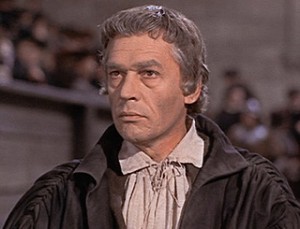 [Right: Paul Scofield as Thomas More, insisting to Parliament that he has not committed treason, in the film version of A Man for All Seasons. Scofield won the Oscar for Best Actor in 1966 for this performance and a BAFTA as well. Source.]
[Right: Paul Scofield as Thomas More, insisting to Parliament that he has not committed treason, in the film version of A Man for All Seasons. Scofield won the Oscar for Best Actor in 1966 for this performance and a BAFTA as well. Source.]
***
***
***
General features of More’s history of Richard
- More probably chose Richard as a topic because of his interest in politics and good government. The book is a foil to Utopia (1516), which discusses perfect government and decries amorality in politics; More saw Richard as the epitome of bad, because amoral, government.
- Humanists saw the point of history as teaching life lessons (historia magistra vitae); despite his many dastardly individual features, Richard in More’s eyes was much more a negative example or pattern rather than a fully formed individual. While More clearly believed what he wrote of Richard to be true, the goal was neither a smear job nor the presentation of evidence about Richard’s reign, but rather the crafting of a tale that criticized amorality, hypocrisy, and vaulting ambition.
- According to scholar George M. Logan, the most important influences on More’s structuring of his history are the Greek author Lucian and the Roman historians Sallust (who wrote histories of the Roman traitors Catiline and Jugurtha) and Tacitus (who wrote a history of the Roman emperor, Tiberius). So great is More’s admiration of Tacitus that he alters facts in his portrayal of Edward IV in order to make his reign seem more like that of Augustus.
- We cannot see More as a straightforward Tudor propagandist; he despised Henry VII.
- More’s history counts as a secondary source in that he did not witness the events he describes. He did draw on primary sources: oral information and reminiscences of people he knew who had lived through events. These included his father (the only source he explicitly names), but more importantly gossip in the household of Bishop John Morton, one of Edward IV’s officials implicated in Hastings’ conspiracy, who survived Richard’s reign. More served in Morton’s household he served as a page from 1490-2.
- While as a public official, More could have consulted extant public records in London, textual comparison suggests that he seems to have done so only once (for Buckingham’s speech of June 26, 1483).
- Though it is extremely unlikely that More knew the work of the second Croyland Continuator, which was unknown outside of its abbey until the later sixteenth century, his account squares with it in important details, another reason to discount the charge that More (or Croyland) were mere Tudor propagandists.
- The only written historical works that More can be proven to have consulted are Fabyan’s New Chronicles of England and France (1516/7) and Great Chronicle of London (ms., 1512).
- No textual evidence suggests that the work on Richard most typically cited as Tudor propaganda, Polydore Vergil’s Anglica historia (ms. 1513), was influential on More.
- The conventions of Renaissance humanist historiography required More to concoct all of the speeches; readers at the time would have known this.
- More’s most prominent literary and linguistic device throughout the work is irony; readers must thus be very careful to discern his meaning, since his words are frequently pointed in specific ways.
- Although the text was one of the most popular works of history in later-sixteenth-century England, it had little influence on history-writing. It made its deepest impact, of course, on Shakespeare, which is the main reason a reader might care about it these days.
- Richard Marius makes the interesting assertion that Richard III is one of the first hypocritical protagonists in the history of western literature.
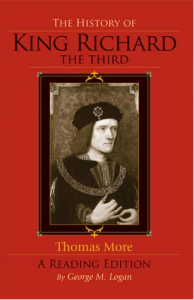 Further reading
Further reading
- Read More’s History of King Richard III on the web, transcribed from the original English edition of 1557 (with original spelling, but modern typography) here.
- If you like books and ready-to-use scholarship, a fantastic update with extensive notes and sixteenth-century usage retained, but modified to reflect modern spelling, has recently been produced: George M. Logan, ed., The History of Richard III: A Reading Edition (Bloomington: Indianapolis University Press, 2005). This is the one my students will be reading.
- Read More’s history in Latin, in the edition that English playwright Ben Jonson used with his notes visible in the margin, at The Center for Thomas More Studies, in digital facsimile.
- Read More’s others works at Center for Thomas More Studies at the University of Dallas as well.
- Richard III Society resources on More’s history, including excerpts from relevant pieces of Marius’ biography, Thomas More: A Biography (New York: Knopf, 1984). (Marius’ biography of More is excellent — a much better work than his disappointingly partisan biography of Martin Luther.)
***
If that’s not too much — I’ll be back next week to discuss some of the fascinating points in More’s retelling of Richard’s story.
Sources Sunday: Introduction
Today I’ll be starting a new feature on King Richard Armitage (to appear as regularly as I can manage), called “Sources Sunday.” In these posts, I’ll look in detail at excerpts from the sources used to write the life and times of Richard III in the last half millennium. I’ll explain their contexts and meanings, and consider the ways in which historians have understood them in the past and how we might look at them today.
***
Couple things to start off — probably elementary for most readers:
- We historians are “source geeks” and “archive rats.” Before we make claims, we like to have evidence. We get our evidence from sources. A source can be anything that we can all examine. The most frequent sources historians use are texts, documents, or material objects, or, in modern history, interviews, photographs, or films and recordings. Sometimes sources disappear entirely, or over long intervals — in those cases, we look at records of those sources as available.
- Historians conventionally divide between primary and secondary sources (although this division is not a strict one). Primary sources stem from the immediate surroundings of the events they capture and include reports by eyewitnesses, recordings, artifacts, and so on. Secondary sources, in contrast, build upon primary sources to provide their accounts of historical matters. Historians concentrate on identifying primary sources for their accounts, although they are not inherently more accurate than secondary sources.
- Ideally, a historian hopes to examine many primary sources. One of the big problems in writing a biography of Richard is that so many primary sources either never existed or have not survived, particularly those that might answer questions that interest us most, so that the first secondary sources, which were negative to Richard, became disproportionately influential.
- Comparing information from different sources allows us to come to judgment about the past. A judgment about the past is more secure, the more often it is corroborated by independent sources (ones that do not simply repeat each other’s claims). Thus we talk about and critique the transmission of particular chains of evidence from source to source. Where a source does not speak, most historians prefer to state that no conclusion can be drawn.
- No source is neutral, just as no history is neutral. Every source, every history, takes a point of view. It’s part of the historian’s job to discern and understand the source’s point of view in order to explain how that affects the information the source gives us. We call this process of assessing the reliability of a source, “source critique.”
- In order to produce a source critique, or explain how information from sources is produced and presented, working historians use a “method” or “methods”; that is, we follow particular rules for drawing conclusions from certain kinds of sources. A method is adapted to its particular kind of source (we use textual methods on texts; mathematical methods on tax records; archaeological methods on bones — and so on). Different methods, when used appropriately, can allow us to see different elements in the same sources — it’s a bit like looking at an object under a UV light vs infrared light vs normal daylight. Similarly, a method will tell us what questions cannot be answered from a particular source.
***
Finally, the point of these posts isn’t to support or refute the case for or against Richard III. Rather, it’s to try to understand the points of view held by the people most responsible for creating his reputation in the last five centuries. In understanding the sources about Richard better, we can come to understand his age and the factors that shaped him — and the people who have written about him — more effectively.
